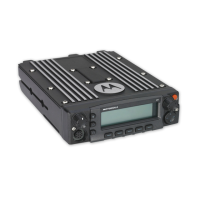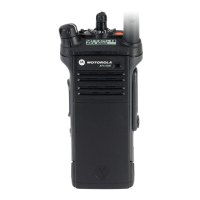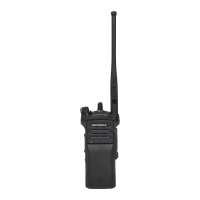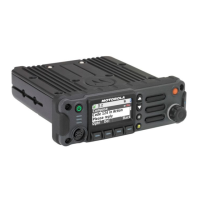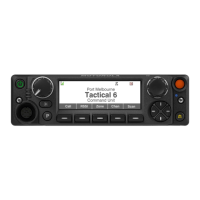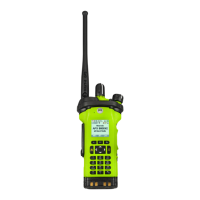Basic Theory of Operation: Digital (ASTRO) Mode of Operation Sec 2: 3-9
3.2.2.1 VHF Transmit
Once a VHF frequency for transmit has been selected, the Trident IC and its accompanying logic
circuitry enable the correct voltage controlled oscillator which then generates the desired transmit
frequency. This transmit signal is then routed to the TX buffer amplifier which amplifies the signal. An
RF switch then routes the signal to the VHF Driver amplifier and then to the discrete final stage. The
signal is then filtered by a harmonic filter and passed through a RF switch into a directional coupler.
The Log Amp power detector monitors the output of the directional coupler and adjusts the control
voltages to the driver amplifier and the discrete final. Finally, the RF signal comes to a Single Pole
double throw (SP2T) RF switch which can route the power to the main antenna or to the Universal
Connector port of the radio.
3.2.2.2 700/800 MHz Transmit
Once a 700/800 MHz frequency for transmit has been selected, the Trident IC and its accompanying
logic circuitry enable the correct voltage controlled oscillator which then generates the desired
transmit frequency. This transmit signal is then routed to the TX buffer amplifier which amplifies the
signal. An RF switch then routes the signal to the 700/800 MHz Driver amplifier and then to the
discrete final stage. The signal is then filtered by a harmonic filter and passed through a RF switch
into a directional coupler. The Log Amp power detector monitors the output of the directional coupler
and adjusts the control voltages to the driver amplifier and the discrete final. Finally, the RF signal
comes to a SP2T RF switch which can route the power to the main antenna or to the Universal
Connector port of the radio.
3.2.2.3 UHF1 Transmit
Once a UHF frequency for transmit has been selected, the Trident IC and its accompanying logic
circuitry enable the correct voltage controlled oscillator which then generates the desired transmit
frequency. This transmit signal is then routed to the TX buffer amplifier which amplifies the signal. An
RF switch then routes the signal to the UHF1 Driver amplifier and then to the discrete final stage.
The signal is then filtered by a harmonic filter and passed through a RF switch into a directional
coupler. The Log Amp power detector monitors the output of the directional coupler and adjusts the
control voltages to the driver amplifier and the discrete final. Finally, the RF signal comes to a Single
Pole double throw (SP2T) RF switch which can route the power to the main antenna or to the
Universal Connector port of the radio.
3.2.2.4 UHF2 Transmit
Once a UHF frequency for transmit has been selected, the Trident IC and its accompanying logic
circuitry enable the correct voltage controlled oscillator which then generates the desired transmit
frequency. This transmit signal is then routed to the TX buffer amplifier which amplifies the signal. An
RF switch then routes the signal to the UHF2 Driver amplifier and then to the discrete final stage.
The signal is then filtered by a harmonic filter and passed through a RF switch into a directional
coupler. The Log Amp power detector monitors the output of the directional coupler and adjusts the
control voltages to the driver amplifier and the discrete final. Finally, the RF signal comes to a Single
Pole double throw (SP2T) RF switch which can route the power to the main antenna or to the
Universal Connector port of the radio.
3.3 Digital (ASTRO) Mode of Operation
In the ASTRO (digital) mode of operation, the transmitted or received signal is limited to a discrete
set of frequency deviation levels. The receiver handles an ASTRO-mode signal identically to an
analog-mode signal, up to the point where the DSP decodes the received data. In the ASTRO
receive mode, the DSP uses a different algorithm to recover data.
In the ASTRO transmit mode, microphone audio is processed identically to an analog mode, with the
exception of the algorithm the DSP uses to encode the information. Using this algorithm, transmitter
FM deviation is limited to discrete levels.
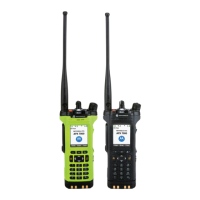
